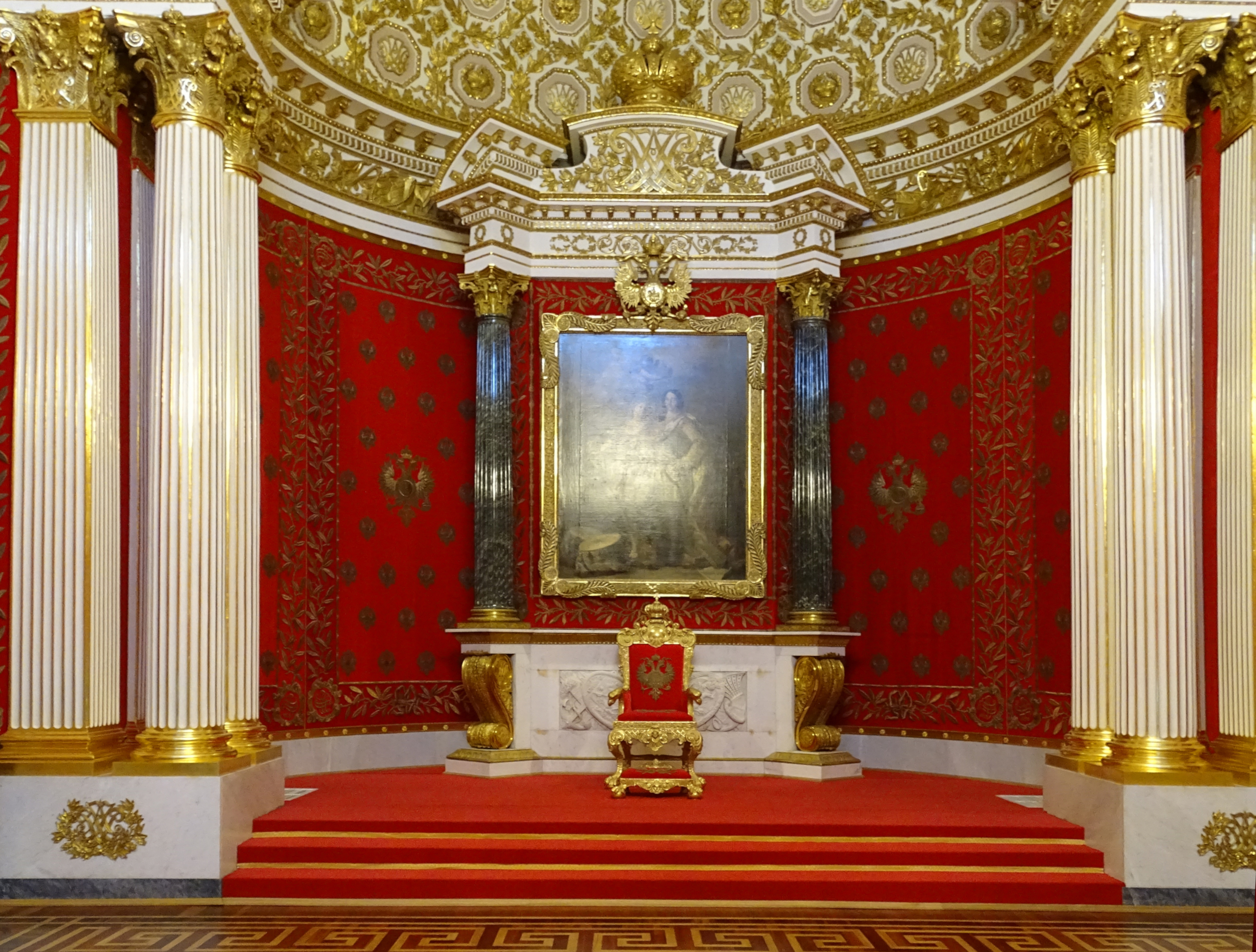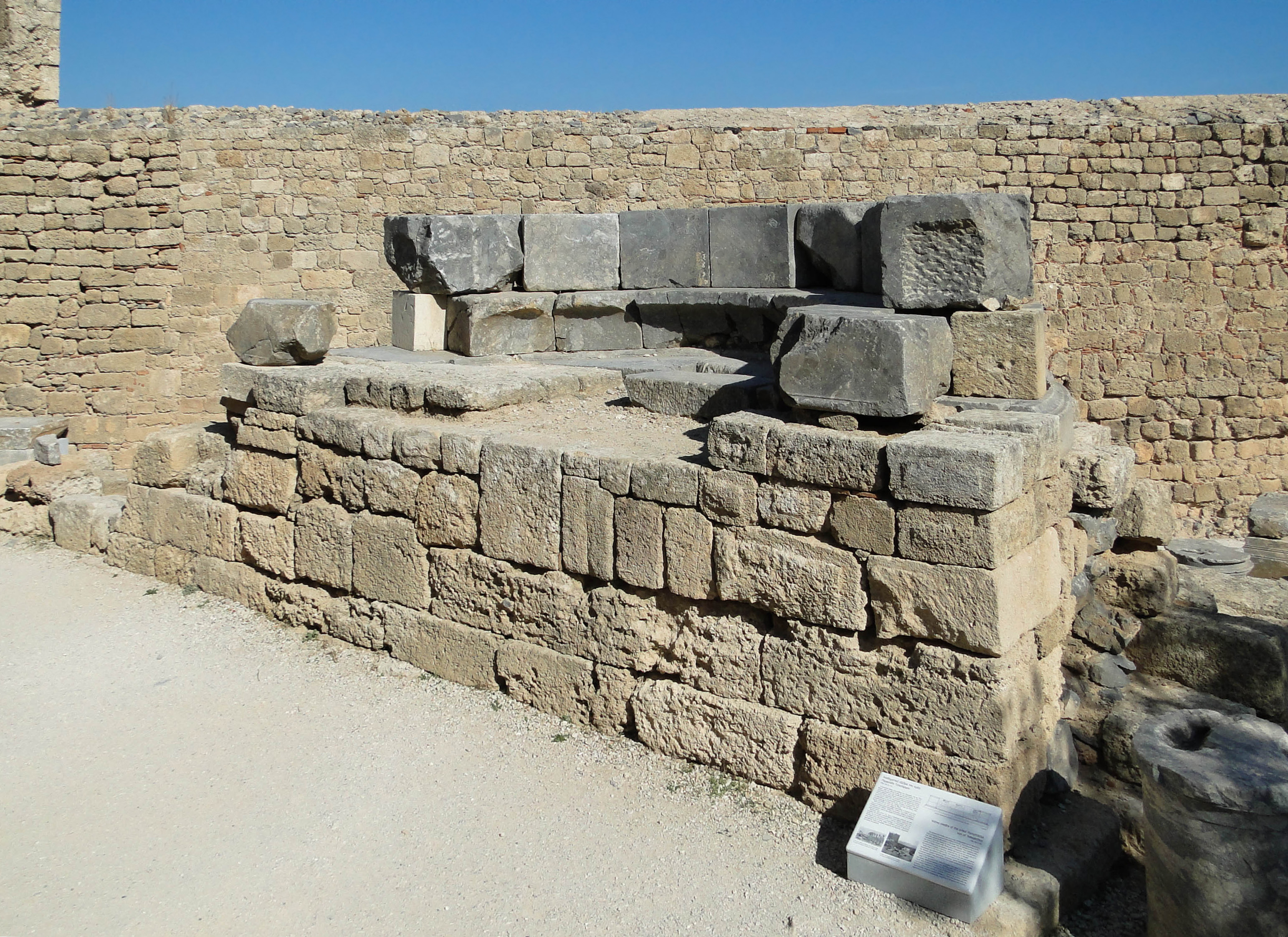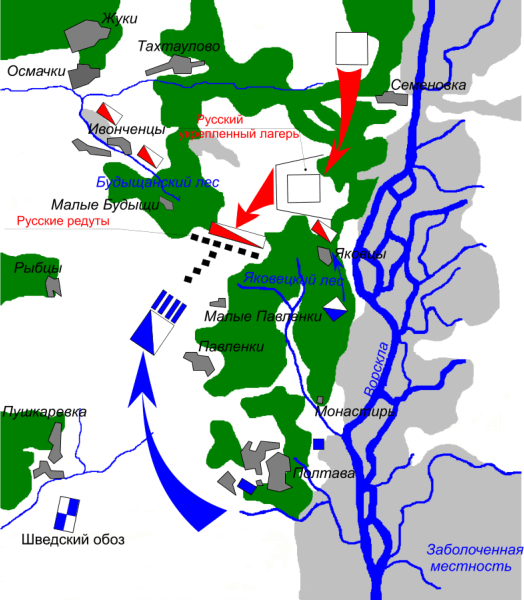|
Small Throne Room Of The Winter Palace
The Small Throne Room of the Winter Palace, St Petersburg, also known as the Peter the Great Memorial Hall, was created for Tsar Nicholas I in 1833, by the architect Auguste de Montferrand. Following a fire in 1837, in which most of the palace was destroyed, the room was recreated exactly as it had been before by the architect Vasily Stasov. Designed in a loose Baroque style, the room holds the throne recessed in an apse before a reredos, supported by two Corinthian columns of jasper, which contains a large canvas dedicated to Peter I with Minerva by Jacopo Amigoni. In the room proper above dado height the walls are lined with crimson velvet embellished with double-headed eagles of silver thread, above which is a shallow vaulted ceiling. Set in the opposing lunettes beneath the vaulting are paintings depicting the Battle of Poltava and the Battle of Lesnaya by Pietro Scotti (1768-1837) and Barnabas Medici. However, the focal point of the room is the silver-gilt throne of ... [...More Info...] [...Related Items...] OR: [Wikipedia] [Google] [Baidu] |
Saint Petersburg Hermitage Small Throne Room 01
In religious belief, a saint is a person who is recognized as having an exceptional degree of holiness, likeness, or closeness to God. However, the use of the term ''saint'' depends on the context and denomination. In Catholic, Eastern Orthodox, Anglican, Oriental Orthodox, and Lutheran doctrine, all of their faithful deceased in Heaven are considered to be saints, but some are considered worthy of greater honor or emulation. Official ecclesiastical recognition, and consequently a public cult of veneration, is conferred on some denominational saints through the process of canonization in the Catholic Church or glorification in the Eastern Orthodox Church after their approval. While the English word ''saint'' originated in Christianity, historians of religion tend to use the appellation "in a more general way to refer to the state of special holiness that many religions attribute to certain people", referring to the Jewish tzadik, the Islamic walī, the Hindu rishi or Sikh ... [...More Info...] [...Related Items...] OR: [Wikipedia] [Google] [Baidu] |
Dado (architecture)
In architecture, the dado is the lower part of a wall, below the dado rail and above the skirting board. The word is borrowed from Italian meaning "dice" or "cube", and refers to "die", an architectural term for the middle section of a pedestal or plinth. Decorative treatment This area is given a decorative treatment different from that for the upper part of the wall; for example panelling, wainscoting or lincrusta. The purpose of the dado treatment to a wall is both aesthetic and functional. Historically, the panelling below the dado rail was installed to cover the lower part of the wall which was subject to stains associated with rising damp; additionally it provided protection from furniture and passing traffic. The dado rail itself is sometimes referred to misleadingly as a chair rail, though its function is principally aesthetic and not to protect the wall from chair backs. Derivation The name was first used in English as an architectural term for the part of a pe ... [...More Info...] [...Related Items...] OR: [Wikipedia] [Google] [Baidu] |
Aedicula
In ancient Roman religion, an ''aedicula'' (plural ''aediculae'') is a small shrine, and in classical architecture refers to a niche covered by a pediment or entablature supported by a pair of columns and typically framing a statue,"aedicula, n." ''OED Online'', Oxford University Press, September 2020www.oed.com/view/Entry/3077 Accessed 29 September 2020."aedicule, n." ''OED Online'', Oxford University Press, September 2020www.oed.com/view/Entry/3079 Accessed 29 September 2020 the early Christian ones sometimes contained funeral urns. Aediculae are also represented in art as a form of ornamentation. The word ''aedicula'' is the diminutive of the Latin ''aedes'', a temple building or dwelling place. The Latin word has been Anglicised as "aedicule" and as "edicule". Classical aediculae Many aediculae were household shrines ( lararia) that held small altars or statues of the Lares and Di Penates. The Lares were Roman deities protecting the house and the family household god ... [...More Info...] [...Related Items...] OR: [Wikipedia] [Google] [Baidu] |
Peter The Great
Peter I ( – ), most commonly known as Peter the Great,) or Pyotr Alekséyevich ( rus, Пётр Алексе́евич, p=ˈpʲɵtr ɐlʲɪˈksʲejɪvʲɪtɕ, , group=pron was a Russian monarch who ruled the Tsardom of Russia from to 1721 and subsequently the Russian Empire until his death in 1725, jointly ruling with his elder half-brother, Ivan V until 1696. He is primarily credited with the modernisation of the country, transforming it into a European power. Through a number of successful wars, he captured ports at Azov and the Baltic Sea, laying the groundwork for the Imperial Russian Navy, ending uncontested Swedish supremacy in the Baltic and beginning the Tsardom's expansion into a much larger empire that became a major European power. He led a cultural revolution that replaced some of the traditionalist and medieval social and political systems with ones that were modern, scientific, Westernised and based on the Enlightenment. Peter's reforms had a last ... [...More Info...] [...Related Items...] OR: [Wikipedia] [Google] [Baidu] |
Exedra
An exedra (plural: exedras or exedrae) is a semicircular architectural recess or platform, sometimes crowned by a semi-dome, and either set into a building's façade or free-standing. The original Greek sense (''ἐξέδρα'', a seat out of doors) was applied to a room that opened onto a stoa, ringed with curved high-backed stone benches, a suitable place for conversation. An exedra may also be expressed by a curved break in a colonnade, perhaps with a semicircular seat. The exedra would typically have an apsidal podium that supported the stone bench. The free-standing (open air) exedra, often supporting bronze portrait sculpture, is a familiar Hellenistic structure, characteristically sited along sacred ways or in open places in sanctuaries, such as at Delos or Epidaurus. Some Hellenistic exedras were built in relation to a city's agora, as in Priene. Monument architects have also used this free-standing style in modern times. Rise The exedra achieved particular popularity i ... [...More Info...] [...Related Items...] OR: [Wikipedia] [Google] [Baidu] |
State Hermitage Museum
The State Hermitage Museum ( rus, Государственный Эрмитаж, r=Gosudarstvennyj Ermitaž, p=ɡəsʊˈdarstvʲɪn(ː)ɨj ɪrmʲɪˈtaʂ, links=no) is a museum of art and culture in Saint Petersburg, Russia. It is the largest art museum in the world by gallery space. It was founded in 1764 when Empress Catherine the Great acquired an impressive collection of paintings from the Berlin merchant Johann Ernst Gotzkowsky. The museum celebrates the anniversary of its founding each year on 7 December, Saint Catherine's Day. It has been open to the public since 1852. The '' Art Newspaper'' ranked the museum 6th in their list of the most visited art museums, with 1,649,443 visitors in 2021. Its collections, of which only a small part is on permanent display, comprise over three million items (the numismatic collection accounts for about one-third of them). The collections occupy a large complex of six historic buildings along Palace Embankment, including the Wint ... [...More Info...] [...Related Items...] OR: [Wikipedia] [Google] [Baidu] |
Diplomat
A diplomat (from grc, δίπλωμα; romanized ''diploma'') is a person appointed by a state or an intergovernmental institution such as the United Nations or the European Union to conduct diplomacy with one or more other states or international organizations. The main functions of diplomats are: representation and protection of the interests and nationals of the sending state; initiation and facilitation of strategic agreements; treaties and conventions; promotion of information; trade and commerce; technology; and friendly relations. Seasoned diplomats of international repute are used in international organizations (for example, the United Nations, the world's largest diplomatic forum) as well as multinational companies for their experience in management and negotiating skills. Diplomats are members of foreign services and diplomatic corps of various nations of the world. The sending state is required to get the consent of the receiving state for a person proposed to se ... [...More Info...] [...Related Items...] OR: [Wikipedia] [Google] [Baidu] |
Silver-gilt
Silver-gilt or gilded/gilt silver, sometimes known in American English by the French term vermeil, is silver (either pure or sterling) which has been gilded with gold. Most large objects made in goldsmithing that appear to be gold are actually silver-gilt; for example most sporting trophies (including medals such as the gold medals awarded in all Olympic Games after 1912) and many crown jewels are silver-gilt objects. Apart from the raw materials being much less expensive to acquire than solid gold of any karat, large silver-gilt objects are also noticeably lighter if lifted, as well as more durable (gold is much heavier than even lead and is easily scratched and bent). For objects that have intricate detail like monstrances, gilding greatly reduces the need for cleaning and polishing, and so reduces the risk of damage. Ungilded silver would suffer oxidation and need frequent polishing; gold does not oxidize at all. The "gold" threads used in embroidered goldwork are normall ... [...More Info...] [...Related Items...] OR: [Wikipedia] [Google] [Baidu] |
Battle Of Lesnaya
The Battle of Lesnaya (russian: Битва при Лесной, Bitva pri Lesnoy; sv, Slaget vid Lesna; pl, Bitwa pod Leśną) was one of the major battles of the Great Northern War. It took place on between a Russian army of between 26,500 and 29,000 men commanded by Peter I of Russia, Mikhail Mikhailovich Golitsyn, Aleksandr Danilovich Menshikov, Christian Felix Bauer and Nikolai Grigorovitj von Werden and a Swedish army of about 12,500 men commanded by Adam Ludwig Lewenhaupt and , at the village of Lesnaya, located close to the border between the Polish–Lithuanian Commonwealth and Russia (now the village of Lyasnaya, south-east of Mogilev in Belarus). The Swedes were escorting a supply column of more than 4,500 wagons for their main army in Ukraine. Peter I intercepted Lewenhaupt's column before it reached the safety of Charles XII, the Swedish king, with the intention of destroying it. After eight hours of fighting, with heavy casualties, neither side stood as winne ... [...More Info...] [...Related Items...] OR: [Wikipedia] [Google] [Baidu] |
Battle Of Poltava
The Battle of Poltava; russian: Полта́вская би́тва; uk, Полта́вська би́тва (8 July 1709) was the decisive and largest battle of the Great Northern War. A Russian army under the command of Tsar Peter I defeated a Swedish army, under the command of Carl Gustaf Rehnskiöld. The battle put an end to the status of the Swedish Empire as a European great power, as well as its eastbound expansion, and marked the beginning of Russian hegemony in Northern Europe. During the course of six years in the initial stages of the war, King Charles XII and the Swedish Empire had defeated almost all participants in the anti-Swedish coalition, which initially consisted of the Polish-Lithuanian Commonwealth, Denmark-Norway and the Tsardom of Russia. The latter under Tsar Peter I's rule was the only one still undefeated. Charles XII therefore chose to invade Russia in the autumn of 1707 and march towards Moscow with a large Swedish army. However, the campaign ... [...More Info...] [...Related Items...] OR: [Wikipedia] [Google] [Baidu] |
Lunettes
A lunette (French ''lunette'', "little moon") is a half-moon shaped architectural space, variously filled with sculpture, painted, glazed, filled with recessed masonry, or void. A lunette may also be segmental, and the arch may be an arc taken from an oval. A lunette window is commonly called a ''half-moon window'', or fanlight when bars separating its panes fan out radially. If a door is set within a round-headed arch, the space within the arch above the door, masonry or glass, is a lunette. If the door is a major access, and the lunette above is massive and deeply set, it may be called a tympanum. A lunette is also formed when a horizontal cornice transects a round-headed arch at the level of the imposts, where the arch springs. If the top of the lunette itself is bordered by a hood mould it can also be considered a pediment. The term is also employed to describe the section of interior wall between the curves of a vault and its springing line. A system of intersecti ... [...More Info...] [...Related Items...] OR: [Wikipedia] [Google] [Baidu] |
Vault (architecture)
In architecture, a vault (French ''voûte'', from Italian ''volta'') is a self-supporting arched form, usually of stone or brick, serving to cover a space with a ceiling or roof. As in building an arch, a temporary support is needed while rings of voussoirs are constructed and the rings placed in position. Until the topmost voussoir, the keystone, is positioned, the vault is not self-supporting. Where timber is easily obtained, this temporary support is provided by centering consisting of a framed truss with a semicircular or segmental head, which supports the voussoirs until the ring of the whole arch is completed. Vault types Corbelled vaults, also called false vaults, with horizontally joined layers of stone have been documented since prehistoric times; in the 14th century BC from Mycenae. They were built regionally until modern times. The real vault construction with radially joined stones was already known to the Egyptians and Assyrians and was introduced into the buil ... [...More Info...] [...Related Items...] OR: [Wikipedia] [Google] [Baidu] |










